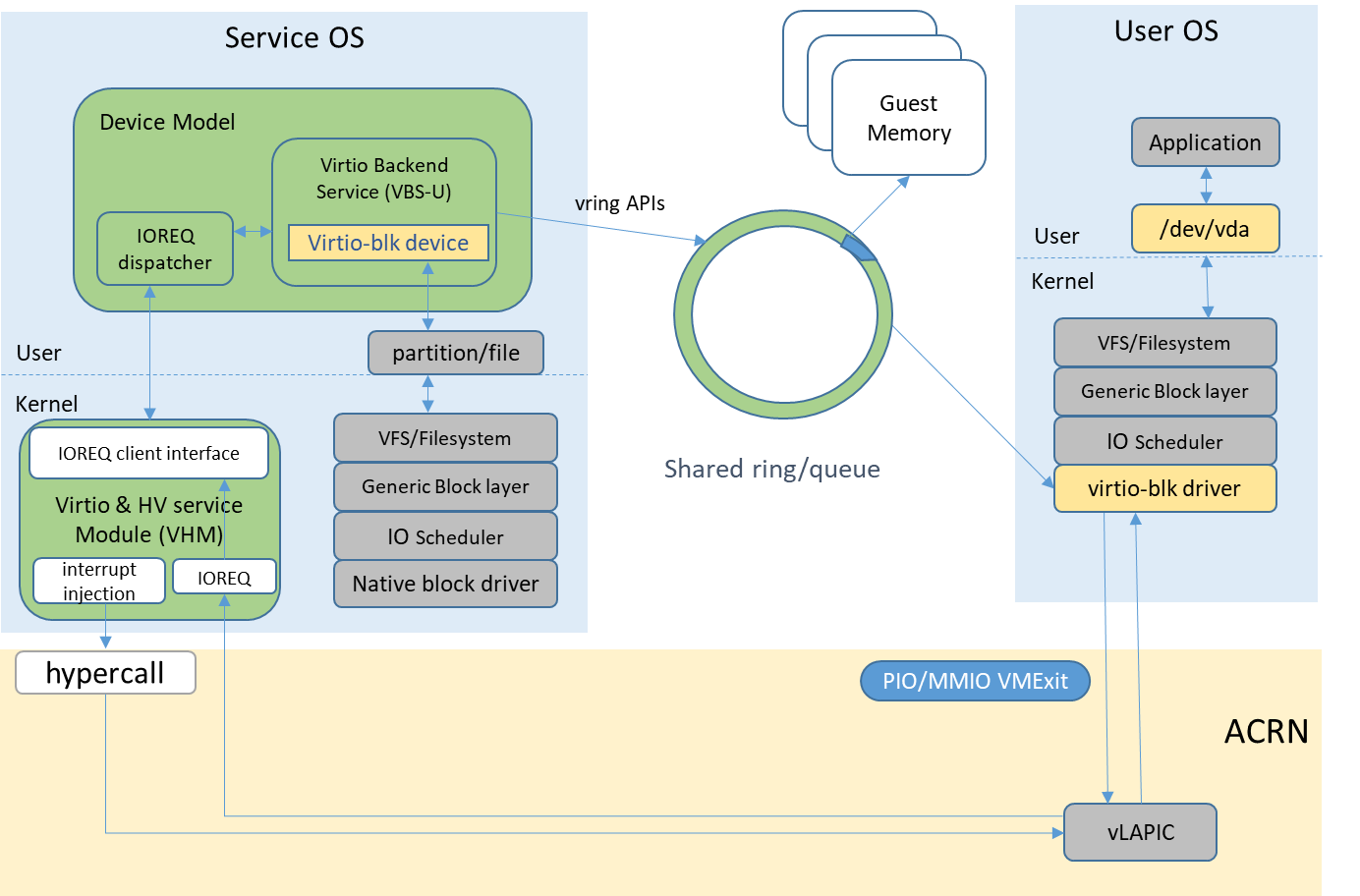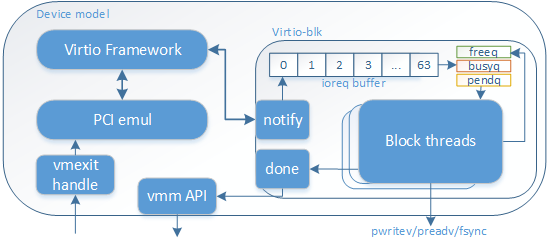Virtio-BLK¶
The virtio-blk device is a simple virtual block device. The FE driver (in the User VM space) places read, write, and other requests onto the virtqueue, so that the BE driver (in the Service VM space) can process them accordingly. Communication between the FE and BE is based on the virtio kick and notify mechanism.
The virtio device ID of the virtio-blk is 2, and it supports one
virtqueue, the size of which is 64, configurable in the source code.

Figure 245 Virtio-blk architecture¶
The feature bits supported by the BE device are shown as follows:
VIRTIO_BLK_F_SEG_MAXMaximum number of segments in a request is in seg_max.
VIRTIO_BLK_F_BLK_SIZEBlock size of disk is in blk_size.
VIRTIO_BLK_F_TOPOLOGYDevice exports information on optimal I/O alignment.
VIRTIO_RING_F_INDIRECT_DESCSupport for indirect descriptors
VIRTIO_BLK_F_FLUSHCache flush command support.
VIRTIO_BLK_F_CONFIG_WCEDevice can toggle its cache between writeback and writethrough modes.
Virtio-BLK BE Design¶

Figure 246 Virtio-BLK BE Design¶
The virtio-blk BE device is implemented as a legacy virtio device. Its backend media could be a file or a partition. The virtio-blk device supports writeback and writethrough cache mode. In writeback mode, virtio-blk has good write and read performance. To be safer, writethrough is set as the default mode, as it can make sure every write operation queued to the virtio-blk FE driver layer is submitted to hardware storage.
During initialization, virtio-blk will allocate 64 ioreq buffers in a shared ring used to store the I/O requests. The freeq, busyq, and pendq shown in Figure 246 are used to manage requests. Each virtio-blk device starts 8 worker threads to process request asynchronously.
Usage:¶
The device model configuration command syntax for virtio-blk is:
-s <slot>,virtio-blk,[,b,]<filepath>[,options]
b: when usingvsblas the virtual bootloader, use this immediately aftervirtio-blkto specify it as a bootable device and the bootable image location.filepathis the path of a file or disk partitionoptionsinclude:writethru: write operation is reported completed only when the data has been written to physical storage.writeback: write operation is reported completed when data is placed in the page cache. Needs to be flushed to the physical storage.ro: open file with readonly mode.sectorsize: configured as eithersectorsize=<sector size>/<physical sector size>orsectorsize=<sector size>. The default values for sector size and physical sector size are 512range: configured asrange=<start lba in file>/<sub file size>meaning the virtio-blk will only access part of the file, from the<start lba in file>to<start lba in file> + <sub file site>.
A simple example for virtio-blk:
Prepare a file in Service VM folder:
dd if=/dev/zero of=test.img bs=1M count=1024 mkfs.ext4 test.img
Add virtio-blk in the DM cmdline, slot number should not duplicate another device:
-s 9,virtio-blk,/root/test.img
Launch User VM, you can find
/dev/vdxin User VM.The
xin/dev/vdxis related to the slot number used. If If you start DM with two virtio-blks, and the slot numbers are 9 and 10, then, the device with slot 9 will be recognized as/dev/vda, and the device with slot 10 will be/dev/vdbMount
/dev/vdxto a folder in the User VM, and then you can access it.
Successful booting of the User VM verifies the correctness of the device.